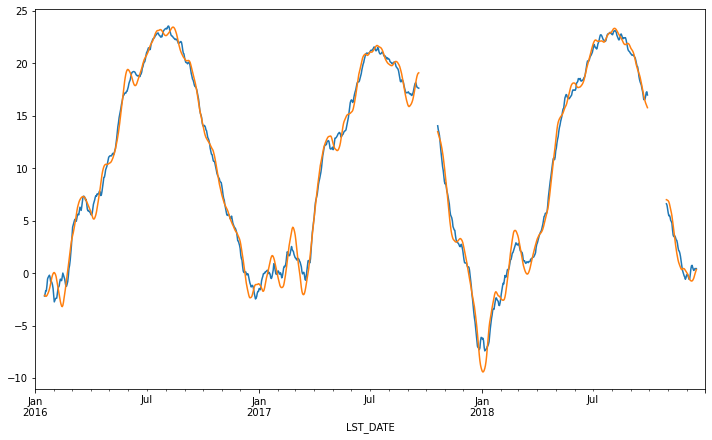Pandas: Groupby¶
groupby is an amazingly powerful function in pandas. But it is also complicated to use and understand.
The point of this notebook is to make you feel confident in using groupby and its cousins, resample and rolling.
These notes are loosely based on the Pandas GroupBy Documentation.
See also
The “split/apply/combine” concept was first introduced in a paper by Hadley Wickham: https://www.jstatsoft.org/article/view/v040i01.
import numpy as np
import pandas as pd
from matplotlib import pyplot as plt
# %config InlineBackend.figure_format = 'retina'
plt.rcParams['figure.figsize'] = (12,7)
plt.ion() # To trigger the interactive inline mode
Use the following code to load a CSV file of the NOAA IBTrACS cyclones dataset:
#url = 'https://www.ncei.noaa.gov/data/international-best-track-archive-for-climate-stewardship-ibtracs/v04r00/access/csv/ibtracs.ALL.list.v04r00.csv'
url = 'ibtracs.last3years.list.v04r00.csv'
df = pd.read_csv(url, parse_dates=['ISO_TIME'], usecols=range(12), index_col='SID',
skiprows=[1], na_values=[' ', 'NOT_NAMED'],
keep_default_na=False, dtype={'NAME': str})
df.head()
| SEASON | NUMBER | BASIN | SUBBASIN | NAME | ISO_TIME | NATURE | LAT | LON | WMO_WIND | WMO_PRES | |
|---|---|---|---|---|---|---|---|---|---|---|---|
| SID | |||||||||||
| 2018004S08095 | 2018 | 1 | SI | WA | IRVING | 2018-01-03 18:00:00 | NR | -8.27000 | 95.3300 | 25.0 | 1004.0 |
| 2018004S08095 | 2018 | 1 | SI | WA | IRVING | 2018-01-03 21:00:00 | NR | -8.36815 | 95.7494 | NaN | NaN |
| 2018004S08095 | 2018 | 1 | SI | WA | IRVING | 2018-01-04 00:00:00 | NR | -8.60000 | 96.0000 | 25.0 | 1004.0 |
| 2018004S08095 | 2018 | 1 | SI | WA | IRVING | 2018-01-04 03:00:00 | NR | -9.03721 | 95.9729 | NaN | NaN |
| 2018004S08095 | 2018 | 1 | SI | WA | IRVING | 2018-01-04 06:00:00 | NR | -9.50000 | 95.8000 | 25.0 | 1004.0 |
Basin Key:
NA - North Atlantic
EP - Eastern North Pacific
WP - Western North Pacific
NI - North Indian
SI - South Indian
SP - Southern Pacific
SA - South Atlantic
An Example¶
This is an example of a “one-liner” that you can accomplish with groupby.
df.groupby('BASIN').WMO_WIND.count().nlargest(20).plot(kind='bar', figsize=(12,6))
<AxesSubplot:xlabel='BASIN'>
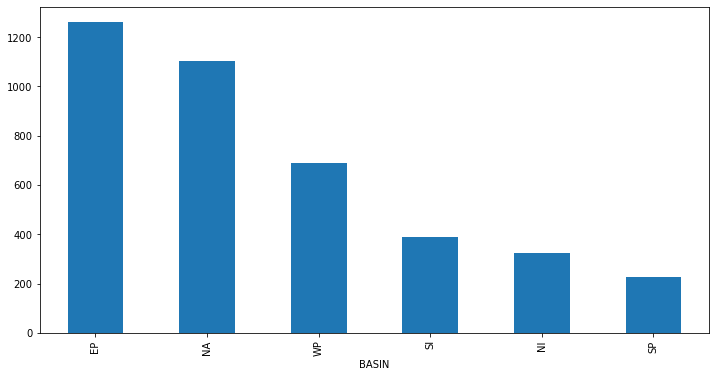
What Happened?¶
Let’s break apart this operation a bit. The workflow with groubpy can be divided into three general steps:
Split: Partition the data into different groups based on some criterion.
Apply: Do some caclulation within each group. Different types of “apply” steps might be
Aggregation: Get the mean or max within the group.
Transformation: Normalize all the values within a group
Filtration: Eliminate some groups based on a criterion.
Combine: Put the results back together into a single object.

The groupby method¶
Both Series and DataFrame objects have a groupby method. It accepts a variety of arguments, but the simplest way to think about it is that you pass another series, whose unique values are used to split the original object into different groups.
df.groupby(df.BASIN)
<pandas.core.groupby.generic.DataFrameGroupBy object at 0x7f3fea07d310>
There is a shortcut for doing this with dataframes: you just pass the column name:
df.groupby('BASIN')
<pandas.core.groupby.generic.DataFrameGroupBy object at 0x7f4016b0e6a0>
The GroubBy object¶
When we call, groupby we get back a GroupBy object:
gb = df.groupby('BASIN')
gb
<pandas.core.groupby.generic.DataFrameGroupBy object at 0x7f3fe9e84880>
The length tells us how many groups were found:
len(gb)
6
All of the groups are available as a dictionary via the .groups attribute:
groups = gb.groups
len(groups)
6
list(groups.keys())
['EP', 'NA', 'NI', 'SI', 'SP', 'WP']
Iterating and selecting groups¶
You can loop through the groups if you want.
for key, group in gb:
display(group.head())
print(f'The key is "{key}"')
break
| SEASON | NUMBER | BASIN | SUBBASIN | NAME | ISO_TIME | NATURE | LAT | LON | WMO_WIND | WMO_PRES | |
|---|---|---|---|---|---|---|---|---|---|---|---|
| SID | |||||||||||
| 2018131N12235 | 2018 | 23 | EP | MM | NaN | 2018-05-10 12:00:00 | TS | 12.1000 | -125.400 | 25.0 | 1008.0 |
| 2018131N12235 | 2018 | 23 | EP | MM | NaN | 2018-05-10 15:00:00 | TS | 12.2101 | -125.790 | NaN | NaN |
| 2018131N12235 | 2018 | 23 | EP | MM | NaN | 2018-05-10 18:00:00 | TS | 12.3000 | -126.200 | 30.0 | 1007.0 |
| 2018131N12235 | 2018 | 23 | EP | MM | NaN | 2018-05-10 21:00:00 | TS | 12.3575 | -126.643 | NaN | NaN |
| 2018131N12235 | 2018 | 23 | EP | MM | NaN | 2018-05-11 00:00:00 | TS | 12.4000 | -127.100 | 30.0 | 1007.0 |
The key is "EP"
And you can get a specific group by key.
gb.get_group('SP').head()
| SEASON | NUMBER | BASIN | SUBBASIN | NAME | ISO_TIME | NATURE | LAT | LON | WMO_WIND | WMO_PRES | |
|---|---|---|---|---|---|---|---|---|---|---|---|
| SID | |||||||||||
| 2018027S11156 | 2018 | 5 | SP | EA | FEHI | 2018-01-26 12:00:00 | DS | -11.4000 | 156.100 | NaN | NaN |
| 2018027S11156 | 2018 | 5 | SP | EA | FEHI | 2018-01-26 15:00:00 | DS | -11.5675 | 156.525 | NaN | NaN |
| 2018027S11156 | 2018 | 5 | SP | EA | FEHI | 2018-01-26 18:00:00 | DS | -11.8000 | 157.000 | NaN | NaN |
| 2018027S11156 | 2018 | 5 | SP | EA | FEHI | 2018-01-26 21:00:00 | DS | -12.1477 | 157.537 | NaN | NaN |
| 2018027S11156 | 2018 | 5 | SP | EA | FEHI | 2018-01-27 00:00:00 | TS | -12.6000 | 158.000 | NaN | NaN |
Aggregation¶
Now that we know how to create a GroupBy object, let’s learn how to do aggregation on it.
One way us to use the .aggregate method, which accepts another function as its argument. The result is automatically combined into a new dataframe with the group key as the index.
We can use both . or [] syntax to select a specific column to operate on. Then we get back a series.
gb.WMO_WIND.aggregate(np.max).head()
BASIN
EP 140.0
NA 160.0
NI 95.0
SI 125.0
SP 110.0
Name: WMO_WIND, dtype: float64
gb.WMO_WIND.aggregate(np.max).nlargest(10)
BASIN
NA 160.0
EP 140.0
SI 125.0
WP 115.0
SP 110.0
NI 95.0
Name: WMO_WIND, dtype: float64
There are shortcuts for common aggregation functions:
gb.WMO_WIND.max().nlargest(10)
BASIN
NA 160.0
EP 140.0
SI 125.0
WP 115.0
SP 110.0
NI 95.0
Name: WMO_WIND, dtype: float64
gb.WMO_WIND.min().nsmallest(10)
BASIN
SI 10.0
EP 15.0
NA 15.0
SP 15.0
NI 20.0
WP 35.0
Name: WMO_WIND, dtype: float64
gb.WMO_WIND.mean().nlargest(10)
BASIN
WP 61.534009
EP 51.912698
NA 50.308810
SP 47.766520
SI 46.231362
NI 41.353846
Name: WMO_WIND, dtype: float64
gb.WMO_WIND.std().nlargest(10)
BASIN
EP 30.176084
NA 24.634510
SP 23.220435
WP 22.915217
SI 22.771114
NI 17.673680
Name: WMO_WIND, dtype: float64
We can also apply multiple functions at once:
gb.WMO_WIND.aggregate([np.min, np.max, np.mean]).head()
| amin | amax | mean | |
|---|---|---|---|
| BASIN | |||
| EP | 15.0 | 140.0 | 51.912698 |
| NA | 15.0 | 160.0 | 50.308810 |
| NI | 20.0 | 95.0 | 41.353846 |
| SI | 10.0 | 125.0 | 46.231362 |
| SP | 15.0 | 110.0 | 47.766520 |
gb.WMO_WIND.aggregate([np.min, np.max, np.mean]).nlargest(10, 'mean').plot(kind='bar')
<AxesSubplot:xlabel='BASIN'>
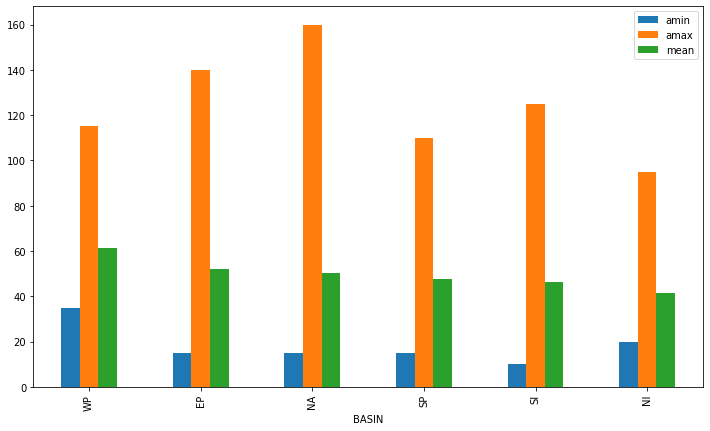
Transformation¶
The key difference between aggregation and transformation is that aggregation returns a smaller object than the original, indexed by the group keys, while transformation returns an object with the same index (and same size) as the original object. Groupby + transformation is used when applying an operation that requires information about the whole group.
In this example, we standardize the earthquakes in each country so that the distribution has zero mean and unit variance. We do this by first defining a function called standardize and then passing it to the transform method.
I admit that I don’t know why you would want to do this. transform makes more sense to me in the context of time grouping operation. See below for another example.
def standardize(x):
return (x - x.mean())/x.std()
wind_standardized_by_basin = gb.WMO_WIND.transform(standardize)
wind_standardized_by_basin
SID
2018004S08095 -0.932381
2018004S08095 NaN
2018004S08095 -0.932381
2018004S08095 NaN
2018004S08095 -0.932381
...
2021067S24058 NaN
2021067S24058 NaN
2021067S24058 NaN
2021067S24058 NaN
2021067S24058 NaN
Name: WMO_WIND, Length: 17783, dtype: float64
Time Grouping¶
We already saw how pandas has a strong built-in understanding of time. This capability is even more powerful in the context of groupby. With datasets indexed by a pandas DateTimeIndex, we can easily group and resample the data using common time units.
To get started, let’s load a NOAA timeseries data:
import urllib
header_url = 'ftp://ftp.ncdc.noaa.gov/pub/data/uscrn/products/daily01/HEADERS.txt'
with urllib.request.urlopen(header_url) as response:
data = response.read().decode('utf-8')
lines = data.split('\n')
headers = lines[1].split(' ')
ftp_base = 'ftp://ftp.ncdc.noaa.gov/pub/data/uscrn/products/daily01/'
dframes = []
for year in range(2016, 2019):
data_url = f'{year}/CRND0103-{year}-NY_Millbrook_3_W.txt'
df = pd.read_csv(ftp_base + data_url, parse_dates=[1],
names=headers, header=None, sep='\s+',
na_values=[-9999.0, -99.0])
dframes.append(df)
df = pd.concat(dframes)
df = df.set_index('LST_DATE')
df.head()
| WBANNO | CRX_VN | LONGITUDE | LATITUDE | T_DAILY_MAX | T_DAILY_MIN | T_DAILY_MEAN | T_DAILY_AVG | P_DAILY_CALC | SOLARAD_DAILY | ... | SOIL_MOISTURE_10_DAILY | SOIL_MOISTURE_20_DAILY | SOIL_MOISTURE_50_DAILY | SOIL_MOISTURE_100_DAILY | SOIL_TEMP_5_DAILY | SOIL_TEMP_10_DAILY | SOIL_TEMP_20_DAILY | SOIL_TEMP_50_DAILY | SOIL_TEMP_100_DAILY | ||
|---|---|---|---|---|---|---|---|---|---|---|---|---|---|---|---|---|---|---|---|---|---|
| LST_DATE | |||||||||||||||||||||
| 2016-01-01 | 64756 | 2.422 | -73.74 | 41.79 | 3.4 | -0.5 | 1.5 | 1.3 | 0.0 | 1.69 | ... | 0.233 | 0.204 | 0.155 | 0.147 | 4.2 | 4.4 | 5.1 | 6.0 | 7.6 | NaN |
| 2016-01-02 | 64756 | 2.422 | -73.74 | 41.79 | 2.9 | -3.6 | -0.4 | -0.3 | 0.0 | 6.25 | ... | 0.227 | 0.199 | 0.152 | 0.144 | 2.8 | 3.1 | 4.2 | 5.7 | 7.4 | NaN |
| 2016-01-03 | 64756 | 2.422 | -73.74 | 41.79 | 5.1 | -1.8 | 1.6 | 1.1 | 0.0 | 5.69 | ... | 0.223 | 0.196 | 0.151 | 0.141 | 2.6 | 2.8 | 3.8 | 5.2 | 7.2 | NaN |
| 2016-01-04 | 64756 | 2.422 | -73.74 | 41.79 | 0.5 | -14.4 | -6.9 | -7.5 | 0.0 | 9.17 | ... | 0.220 | 0.194 | 0.148 | 0.139 | 1.7 | 2.1 | 3.4 | 4.9 | 6.9 | NaN |
| 2016-01-05 | 64756 | 2.422 | -73.74 | 41.79 | -5.2 | -15.5 | -10.3 | -11.7 | 0.0 | 9.34 | ... | 0.213 | 0.191 | 0.148 | 0.138 | 0.4 | 0.9 | 2.4 | 4.3 | 6.6 | NaN |
5 rows × 28 columns
This timeseries has daily resolution, and the daily plots are somewhat noisy.
df.T_DAILY_MEAN.plot()
<AxesSubplot:xlabel='LST_DATE'>
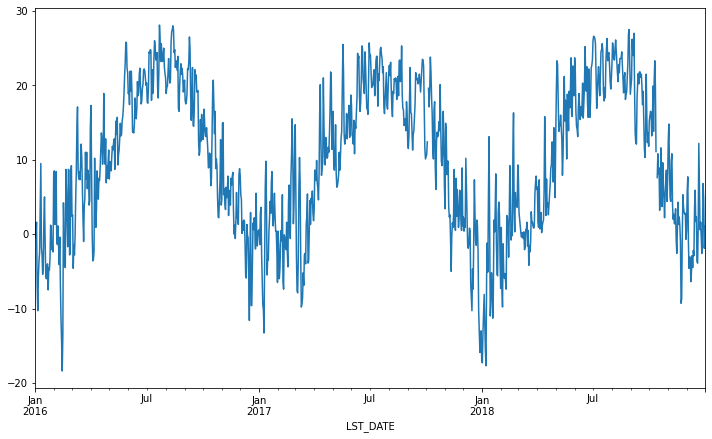
A common way to analyze such data in climate science is to create a “climatology,” which contains the average values in each month or day of the year. We can do this easily with groupby. Recall that df.index is a pandas DateTimeIndex object.
monthly_climatology = df.groupby(df.index.month).mean()
monthly_climatology
| WBANNO | CRX_VN | LONGITUDE | LATITUDE | T_DAILY_MAX | T_DAILY_MIN | T_DAILY_MEAN | T_DAILY_AVG | P_DAILY_CALC | SOLARAD_DAILY | ... | SOIL_MOISTURE_10_DAILY | SOIL_MOISTURE_20_DAILY | SOIL_MOISTURE_50_DAILY | SOIL_MOISTURE_100_DAILY | SOIL_TEMP_5_DAILY | SOIL_TEMP_10_DAILY | SOIL_TEMP_20_DAILY | SOIL_TEMP_50_DAILY | SOIL_TEMP_100_DAILY | ||
|---|---|---|---|---|---|---|---|---|---|---|---|---|---|---|---|---|---|---|---|---|---|
| LST_DATE | |||||||||||||||||||||
| 1 | 64756 | 2.488667 | -73.74 | 41.79 | 2.924731 | -7.122581 | -2.100000 | -1.905376 | 2.478495 | 5.812258 | ... | 0.240250 | 0.199528 | 0.150387 | 0.162554 | 0.168817 | 0.232258 | 0.788172 | 1.749462 | 3.395699 | NaN |
| 2 | 64756 | 2.487882 | -73.74 | 41.79 | 6.431765 | -5.015294 | 0.712941 | 1.022353 | 4.077647 | 8.495882 | ... | 0.244229 | 0.203089 | 0.154294 | 0.165494 | 1.217647 | 1.183529 | 1.281176 | 1.602353 | 2.460000 | NaN |
| 3 | 64756 | 2.488667 | -73.74 | 41.79 | 7.953763 | -3.035484 | 2.455914 | 2.643011 | 2.788172 | 13.211290 | ... | 0.224155 | 0.190753 | 0.153108 | 0.161742 | 3.469892 | 3.407527 | 3.379570 | 3.473118 | 3.792473 | NaN |
| 4 | 64756 | 2.488667 | -73.74 | 41.79 | 14.793333 | 1.816667 | 8.302222 | 8.574444 | 2.396667 | 15.295889 | ... | 0.208611 | 0.183922 | 0.150022 | 0.159956 | 9.402222 | 9.140000 | 8.438889 | 7.600000 | 6.633333 | NaN |
| 5 | 64756 | 2.488667 | -73.74 | 41.79 | 21.235484 | 8.460215 | 14.850538 | 15.121505 | 3.015054 | 17.288602 | ... | 0.198925 | 0.175441 | 0.146011 | 0.157710 | 16.889247 | 16.693548 | 15.570968 | 14.193548 | 12.344086 | NaN |
| 6 | 64756 | 2.488667 | -73.74 | 41.79 | 25.627778 | 11.837778 | 18.733333 | 19.026667 | 3.053333 | 21.913333 | ... | 0.132867 | 0.127067 | 0.128344 | 0.154989 | 22.372222 | 22.198889 | 20.917778 | 19.421111 | 17.453333 | NaN |
| 7 | 64756 | 2.488667 | -73.74 | 41.79 | 28.568817 | 15.536559 | 22.054839 | 22.012903 | 3.865591 | 21.570645 | ... | 0.100871 | 0.084978 | 0.112516 | 0.153264 | 25.453763 | 25.408602 | 24.141935 | 22.725806 | 20.994624 | NaN |
| 8 | 64756 | 2.488667 | -73.74 | 41.79 | 27.473118 | 15.351613 | 21.410753 | 21.378495 | 4.480645 | 18.493333 | ... | 0.150914 | 0.121323 | 0.125398 | 0.162667 | 24.784946 | 24.897849 | 24.117204 | 23.311828 | 22.278495 | NaN |
| 9 | 64756 | 2.488667 | -73.74 | 41.79 | 24.084444 | 12.032222 | 18.057778 | 17.866667 | 3.730000 | 13.625667 | ... | 0.131133 | 0.113678 | 0.117722 | 0.157660 | 21.061111 | 21.220000 | 20.947778 | 20.823333 | 20.717778 | NaN |
| 10 | 64756 | 2.548882 | -73.74 | 41.79 | 18.127473 | 5.757143 | 11.938462 | 11.952747 | 3.228261 | 9.442527 | ... | 0.144363 | 0.103879 | 0.112703 | 0.147246 | 14.901099 | 15.050549 | 15.360440 | 16.113187 | 17.113187 | NaN |
| 11 | 64756 | 2.555333 | -73.74 | 41.79 | 9.586667 | -1.375556 | 4.097778 | 4.277778 | 3.991111 | 6.350111 | ... | 0.213856 | 0.174800 | 0.149300 | 0.159456 | 6.845556 | 6.918889 | 7.663333 | 8.987778 | 11.007778 | NaN |
| 12 | 64756 | 2.555333 | -73.74 | 41.79 | 3.569892 | -5.704301 | -1.069892 | -0.850538 | 2.791398 | 4.708602 | ... | 0.231729 | 0.188398 | 0.156817 | 0.172882 | 1.896774 | 1.964516 | 2.658065 | 3.869892 | 5.846237 | NaN |
12 rows × 27 columns
Each row in this new dataframe respresents the average values for the months (1=January, 2=February, etc.)
We can apply more customized aggregations, as with any groupby operation. Below we keep the mean of the mean, max of the max, and min of the min for the temperature measurements.
monthly_T_climatology = df.groupby(df.index.month).aggregate({'T_DAILY_MEAN': 'mean',
'T_DAILY_MAX': 'max',
'T_DAILY_MIN': 'min'})
monthly_T_climatology.head()
| T_DAILY_MEAN | T_DAILY_MAX | T_DAILY_MIN | |
|---|---|---|---|
| LST_DATE | |||
| 1 | -2.100000 | 16.9 | -26.0 |
| 2 | 0.712941 | 24.9 | -24.7 |
| 3 | 2.455914 | 26.8 | -16.5 |
| 4 | 8.302222 | 30.6 | -11.3 |
| 5 | 14.850538 | 33.4 | -1.6 |
monthly_T_climatology.plot(marker='o')
<AxesSubplot:xlabel='LST_DATE'>
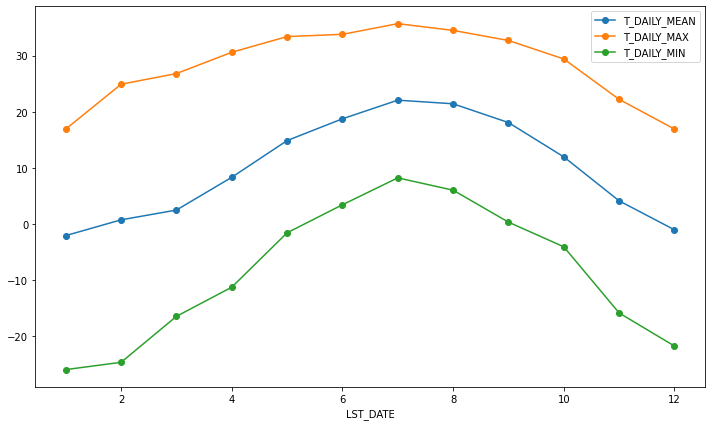
If we want to do it on a finer scale, we can group by day of year.
daily_T_climatology = df.groupby(df.index.dayofyear).aggregate({'T_DAILY_MEAN': 'mean',
'T_DAILY_MAX': 'max',
'T_DAILY_MIN': 'min'})
daily_T_climatology.plot(marker='.')
<AxesSubplot:xlabel='LST_DATE'>
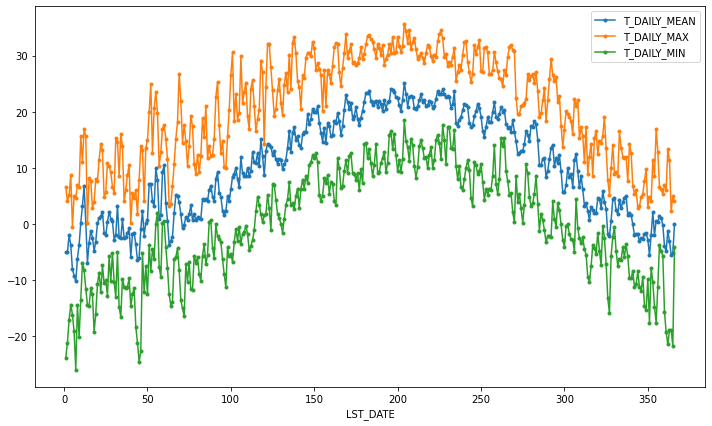
Calculating anomalies¶
A common mode of analysis in climate science is to remove the climatology from a signal to focus only on the “anomaly” values. This can be accomplished with transformation.
def standardize(x):
return (x - x.mean())/x.std()
anomaly = df.groupby(df.index.month).transform(standardize)
anomaly.plot(y='T_DAILY_MEAN')
<AxesSubplot:xlabel='LST_DATE'>
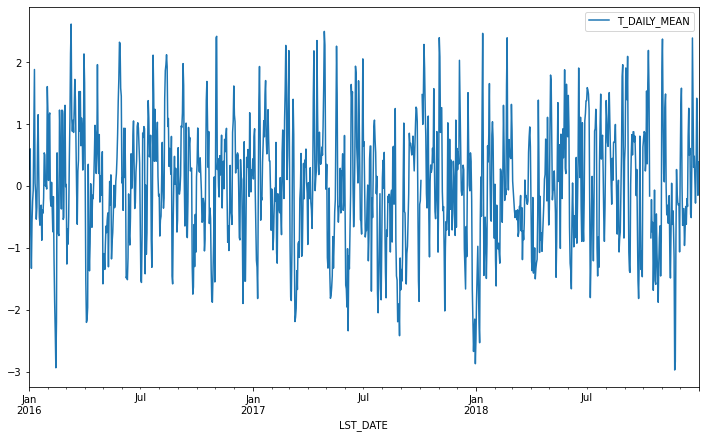
Resampling¶
Another common operation is to change the resolution of a dataset by resampling in time. Pandas exposes this through the resample function. The resample periods are specified using pandas offset index syntax.
Below we resample the dataset by taking the mean over each month.
df.resample('M').mean().plot(y='T_DAILY_MEAN', marker='o')
<AxesSubplot:xlabel='LST_DATE'>
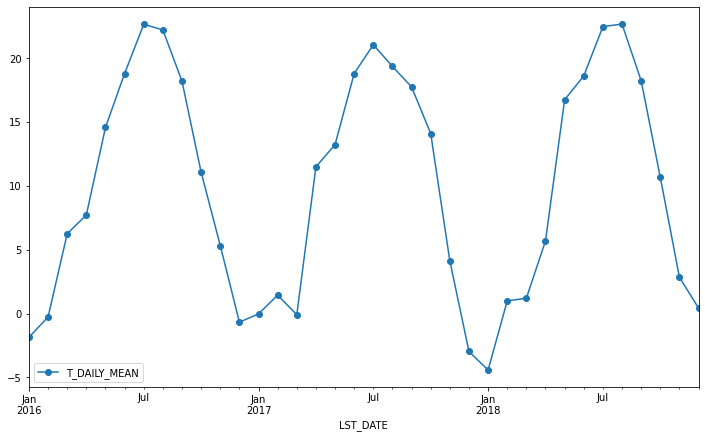
Just like with groupby, we can apply any aggregation function to our resample operation.
df.resample('M').max().plot(y='T_DAILY_MAX', marker='o')
<AxesSubplot:xlabel='LST_DATE'>
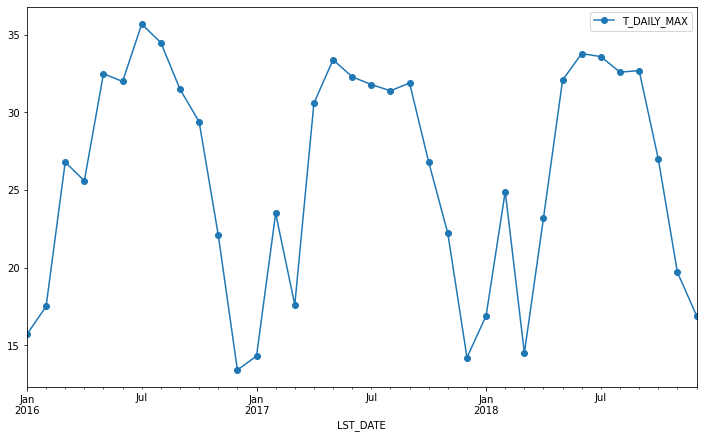
Rolling Operations¶
The final category of operations applies to “rolling windows”. (See rolling documentation.) We specify a function to apply over a moving window along the index. We specify the size of the window and, optionally, the weights. We also use the keyword centered to tell pandas whether to center the operation around the midpoint of the window.
df.rolling(30, center=True).T_DAILY_MEAN.mean().plot()
df.rolling(30, center=True, win_type='triang').T_DAILY_MEAN.mean().plot()
<AxesSubplot:xlabel='LST_DATE'>
